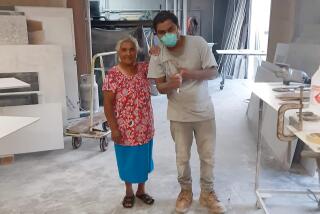Jury Finds Surgeon Not at Fault for Clamp Left Inside a Patient
- Share via
A jury ruled Wednesday that a Canoga Park emergency room surgeon was not responsible for leaving a 7 3/4-inch steel clamp attached to a patient’s stomach, where it remained for more than seven weeks after a 1983 operation.
Testimony during a malpractice trial in Van Nuys Superior Court established that the patient, Robert Blough, 65, of Woodland Hills, carried the scissors-shaped device in his abdomen for six weeks--unaware of its presence--until it was revealed by an X-ray. Another physician had ordered the X-rays because Blough complained of urinary problems.
The clamp was removed nine days later.
Parkwood Community Hospital, where the surgery was performed, settled with Blough for $12,500, attorneys said. Blough also sought $150,000 in damages from Dr. John Matrisciano, who performed the emergency operation to repair a perforated ulcer in Blough’s small intestine on Jan. 3, 1983.
After deliberating one day, however, the jury voted 9 to 3 that Matrisciano was not negligent. Several jurors said they believed there was negligence, but that Blough’s attorney, J. Howard Standing, failed to prove that Matrisciano was responsible. They said they felt that others on the surgical team could have been to blame.
Other jurors said Blough appeared to them to be trying to “beat the system.”
“Ever since he found out that device was in his stomach, he was out to get everything he could from everybody,” said a juror who declined to give his name.
The case hinged on the question of who is responsible for the accuracy of the procedures taken after an operation to ensure that all instruments have been removed from a patient.
Matrisciano’s attorney, Alfred W. Omansky, said the doctor testified that the clamp, used to hold the stomach out of the way during the procedure, must have slipped out of sight under the stomach. The surgeon did not detect it, he said, when he examined the patient’s organs by hand before closing the incision.
In his post-operation report, Matrisciano wrote that he asked the scrub and surgical nurses if they had counted the sponges, clamps and needles used in the operation, and that they reported a correct count.
Omansky argued to the jury that, under the commonly used legal standard for medical care, a surgeon is justified in relying upon the accuracy of the nurse’s count and that the plaintiff must prove a deviation from the standard to find negligence.
Standing contended, however, that, under the “captain of the ship” principle, the surgeon is responsible for everything that happens in the operating room.
Jurors said that, during deliberations, they asked Judge Robert M. Letteau whether the surgeon is responsible for actions that are routinely performed outside of his immediate direction. They said Letteau told them that was up to their interpretation of the situation.
Standing said he intends to appeal.
More to Read
Sign up for Essential California
The most important California stories and recommendations in your inbox every morning.
You may occasionally receive promotional content from the Los Angeles Times.














